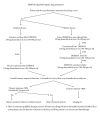Hepatic arterial therapy with drug-eluting beads in the management of metastatic bronchogenic carcinoma to the liver: a multi-institutional registry
- PMID: 22481920
- PMCID: PMC3317121
- DOI: 10.1155/2012/292131
Hepatic arterial therapy with drug-eluting beads in the management of metastatic bronchogenic carcinoma to the liver: a multi-institutional registry
Abstract
Introduction. There has been limited information reported on the use of hepatic arterial therapy in liver dominant hepatic metastases arising from lung cancer. The aim of this study was to evaluate the safety and efficacy of hepatic arterial therapy in the treatment of liver dominant hepatic metastases arising from lung cancer. Methods. Thirteen patients underwent a total of 30 treatment sessions with Drug-Eluting Beads. Eight of the thirteen received only doxorubicin DEB (17 of the total treatments), and four patients received Irinotecan DEB (7 of the total treatments). Results. The planned preprocedural dosage was a median of 75 mg (range 19-200), with total hepatic dose exposure being a median of 150 mg (range 0-458), with a technical success rate of 97% in all 29 treatments. There were 4 adverse events related to treatment, but no evidence of hepatic insufficiency. Overall 6-month and 12-month response rates were 50%. After a median followup of 24 months, the median overall survival in this cohort was 14 months (range 7-48 months). Conclusion. Drug-eluting beads loaded with doxorubicin (DEBDOX) or irinotecan (DEBIRI) can be safely and effectively used in treatment of patients with liver predominant metastatic disease from lung cancer.
Figures
Similar articles
-
Hepatic arterial therapy with drug-eluting beads in the management of metastatic pancreatic carcinoma to the liver: a multi-institutional registry.J Oncol. 2012;2012:168303. doi: 10.1155/2012/168303. Epub 2012 Feb 15. J Oncol. 2012. PMID: 22481917 Free PMC article.
-
Efficacy and Toxicity of Hepatic Intra-Arterial Drug-Eluting (Irinotecan) Bead (DEBIRI) Therapy in Irinotecan-Refractory Unresectable Colorectal Liver Metastases.World J Surg. 2016 May;40(5):1178-90. doi: 10.1007/s00268-015-3386-9. World J Surg. 2016. PMID: 26711640
-
Hepatic intra-arterial injection of drug-eluting bead, irinotecan (DEBIRI) in unresectable colorectal liver metastases refractory to systemic chemotherapy: results of multi-institutional study.Ann Surg Oncol. 2011 Jan;18(1):192-8. doi: 10.1245/s10434-010-1288-5. Epub 2010 Aug 26. Ann Surg Oncol. 2011. PMID: 20740319
-
Transarterial chemoembolization with irinotecan beads in the treatment of colorectal liver metastases: systematic review.J Vasc Interv Radiol. 2013 Aug;24(8):1209-17. doi: 10.1016/j.jvir.2013.05.055. J Vasc Interv Radiol. 2013. PMID: 23885916 Review.
-
Hepatic intra-arterial injection of irinotecan drug eluting beads (DEBIRI) for patients with unresectable colorectal liver metastases: A systematic review.Surg Oncol. 2017 Sep;26(3):268-275. doi: 10.1016/j.suronc.2017.05.003. Epub 2017 May 22. Surg Oncol. 2017. PMID: 28807246 Review.
Cited by
-
Yttrium-90 microsphere radioembolization for treatment of lung cancer hepatic metastases.Case Rep Oncol. 2012 May;5(2):479-86. doi: 10.1159/000342706. Epub 2012 Aug 30. Case Rep Oncol. 2012. PMID: 23109925 Free PMC article.
-
Metastatic disease to the liver: Locoregional therapy strategies and outcomes.World J Clin Oncol. 2021 Sep 24;12(9):725-745. doi: 10.5306/wjco.v12.i9.725. World J Clin Oncol. 2021. PMID: 34631439 Free PMC article. Review.
References
-
- Silvestri GA, Littenberg B, Colice GL. The clinical evaluation for detecting metastatic lung cancer: a meta- analysis. American Journal of Respiratory and Critical Care Medicine. 1995;152(1):225–230. - PubMed
-
- Socinski MA, Crowell R, Hensing TE, et al. Treatment of non-small cell lung cancer, stage IV: ACCP evidence-based clinical practice guidelines (2nd edition) Chest. 2007;132(supplement 3):277S–289S. - PubMed
LinkOut - more resources
Full Text Sources


